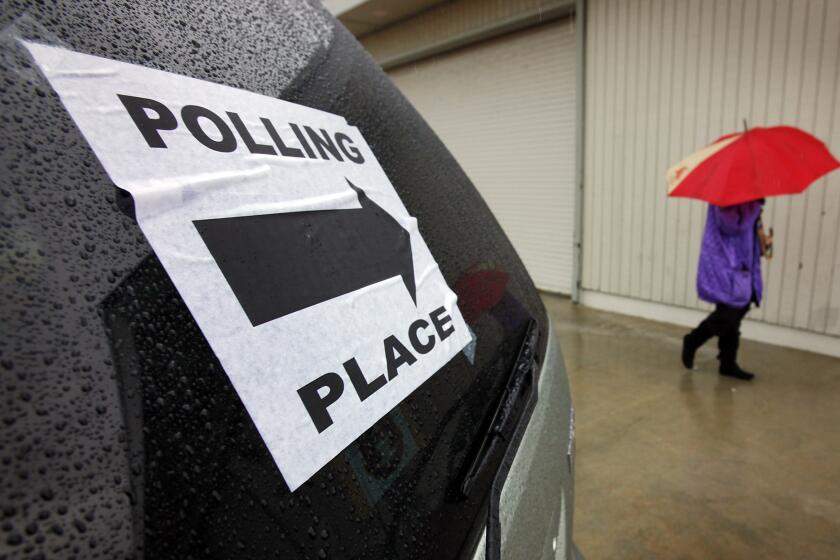The Pennsylvania story
If you’re looking for a bellwether race that might tell you early on election night how the congressional elections will turn out nationwide, look to Pennsylvania.
The Senate race here is as pure a version of the national debate as you’re likely to find, and it’s in a state that often reflects the mood of the country as a whole. According to recent polls, the race is a dead heat.
The Democratic candidate is Rep. Joe Sestak, a retired Navy admiral who says he’s proud of his votes for President Obama’s economic stimulus and healthcare bills — although these days, he rarely mentions Obama by name.
The Republican is Pat Toomey, a former congressman who was a fiscal conservative before the “tea party” even existed — although these days, he’s trying to avoid being lumped in with his party’s more exotic candidates in other states.
They’re running for a seat Republicans need if they hope to take over the Senate.
Pennsylvania is a big swing state; it has voted for Democratic presidential candidates five times in a row, but often by small margins. Arlen Specter, the sitting senator whose seat is being fought for, left the Republican Party after Toomey mounted a conservative challenge, and then lost the Democratic primary to the more liberal Sestak. Many of the state’s white, working-class voters wanted Hillary Rodham Clinton for president; they got Obama instead. Pennsylvania is increasingly post-industrial, but it’s still been battered by the recession, with unemployment at about 9%.
For most of the summer, Toomey was well ahead in the polls, buoyed by conservative enthusiasm and liberal gloom. Democratic strategists had nearly given up the race for lost.
But in recent weeks, Sestak, a dogged and disciplined campaigner, has inched back to a virtual tie, thanks to the slow return of Democratic voters to his camp and a barrage of tough television commercials, including one — a potential first in the annals of political advertising — that shows the candidate cleaning up after his family’s miniature poodle, Belle.
“It made me sick to have to bail out the banks,” Sestak says as he deposits a small plastic bag in a garbage can. “But I had to clean up the mess these guys made.” Behind him appear the faces of “these guys”: Toomey and former President George W. Bush.
Except for the adorable-looking dog, that commercial tells a lot about this campaign: It’s blunt, it’s negative, and it’s all about candidates trying to tie their opponents to everything voters don’t like about the state of the nation.
Sestak is trying to run not only against Toomey but against Bush, former Alaska Gov. Sarah Palin and even Christine O’Donnell, the Republican candidate for Senate in neighboring Delaware, who vaulted to national fame when she had to explain that although she had once dabbled in witchcraft, she is not currently a witch.
“Palin, Toomey, O’Donnell: They all would like to overturn Roe versus Wade,” Sestak said at a debate between the two candidates in Philadelphia.
Toomey, in turn, is running not only against Sestak but against Obama, the stimulus bill and liberalism in general. “Joe Sestak is clearly to the left of even the Democratic consensus, advocating and supporting the most expansive agenda that we’ve ever seen in our lifetimes — serial bailouts, nationalizing whole industries, staggering amount of spending,” he charged.
The debate, like the rest of the campaign, was almost entirely negative. Sestak charged that Toomey would try to turn Social Security into a system of individual investment accounts, but he didn’t offer a plan to solve the nation’s long-term fiscal problems. Toomey alleged that Obama’s (and Sestak’s) new healthcare law would lead to “government-run healthcare,” but he didn’t say what he would advocate instead.
And the exchange reflected the two parties’ basic strategies: Republicans seeking to channel voters’ anger over high unemployment, even though the economy crashed under a GOP president; Democrats struggling to prod their dispirited supporters to the polls by warning that Social Security and abortion rights, two of their ancient touchstones, will be in danger if the GOP wins.
Is Sestak’s late Democratic surge enough to stop what still looks like a Republican wave? I went to a Chamber of Commerce breakfast in Philadelphia’s northern suburbs, one of the state’s swing-vote battlegrounds, to talk to voters.
Robert J. Whalen, 60, an information technology salesman from Langhorne, said he planned to vote Democratic. “It feels like a choice between progress and retrenchment,” he said. “I don’t think we can get out of this crisis by pulling back.”
But even Whalen said he didn’t think Sestak’s attempt to link Toomey to Palin and O’Donnell was working. “That doesn’t play here,” Whalen said. “Toomey doesn’t come across as a tea party guy.”
Another chamber member, retired hospital administrator John Yoder, said he was torn.
“To me, it’s a tie,” said Yoder, 79, of Washington Crossing. “I’m not a tea party guy; I’m more of a Teddy Roosevelt guy.”
He said that the economy made him want to vote Republican but that his support for abortion rights made him want to vote Democratic.
“I’ll say this, though,” he added. “I do believe in the separation of powers. You give the whole thing to one party, it’s not good.”
According to the most recent polls, the race is too close to call. If I had to guess, I’d give Toomey the edge, based on the enthusiasm gap between the two parties’ voters, but that’s only a hunch.
The outcome will depend, of course, on how many voters each side can turn out. Those numbers will tell us something about whether the Republicans’ expected wave is a tsunami or merely a ripple — and whether the GOP will have a mandate for big change or merely benefit from Americans’ disappointment with Obama and their long-held preference for divided government.
More to Read
Get the L.A. Times Politics newsletter
Deeply reported insights into legislation, politics and policy from Sacramento, Washington and beyond. In your inbox three times per week.
You may occasionally receive promotional content from the Los Angeles Times.











